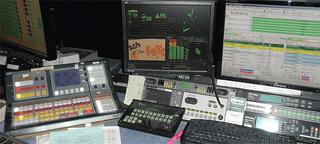It's More Than Just a Switcher
JOHNSTON, IOWA—Over the last few months I have been reviewing service agreements on some of the systems that we use at IPTV. I look at a number of different criteria for the evaluations. Considerations like the age of the systems covered, how critical the system is to the operation, how much utilized the agreement and of course, how much does it cost.
As part of the analysis, I have to quickly determine whether or not the system in question is still performing up to expectations and meeting our needs. Two of the systems that I looked at recently were the Grass Valley Kalypso production switcher in our primary control room and the Grass Valley Kayak production switcher in our remote truck. Both of these switchers continue to perform well for us and while we have actually had to make a few calls to the factory for service and parts, I am not unhappy with either switcher. Probably the biggest problem we dealt with over the last year was a flaky M/E lever on the Kalypso. We've also replaced a few switches on the control panel.

IPTV’s Utah Scientific control panel
I find it somewhat amusing that the mechanical components seem to be the biggest issue. Some would suggest that this fact argues for utilizing software-based controls. I, on the other hand would suggest that the mechanical components be manufactured to a higher standard as the construction of the levers and switches on these and every other switcher I have looked at are far too flimsy to stand up and endure the way their predecessors did.
SWITCHERS VS. ROUTERS
While observing the operation of the control room production switcher I also had a bit of an epiphany. One of the first dilemmas I noted as IT-based infrastructures began to appear in broadcast environments was how each industry defined routers and switches. I observed that what we in the broadcast industry refer to as a router, is a switch in IT lingo and what we call a switcher I noted was really a router to IT folks. It wasn't a perfect analogy because what I was thinking about was the sophistication within each device as defined by the two groups. In broadcast tradition a router is pretty plain vanilla while a switcher has extensive capabilities well beyond simply switching between sources. In IT land the router is the more capable device for interconnection while the switch is the more simple device.

IPTV’s Grass Valley Kalypso
I began to realize where my analogy fell apart was in the actual capabilities that exist within the broadcast switcher. I think part of the confusion is that we have really misnamed the switcher or more appropriately we didn't fundamentally change the name when the capabilities of the switcher grew. I have a vague recollection of being told a brief history of switchers when I was purchasing my first one for a small station in Honolulu. As it was told to me, in the early days of television, back when we still used cameras with turret lenses and genlocking wasn't around, a method for switching between cameras was to go to black and then make the switch. This minimized the impact of the vertical roll that would happen on televisions as they relocked to the sync pulses from the new video's source. It also covered up the ugly rotation of the turret lens. The origins may have been with the theater where the lights would go down to allow for set changes during a play. So punch the black source and then punch the next video source and reduce the impact of the vertical roll. The accuracy of this information may not be 100 percent but I remember at the time it seemed pretty credible to me.
SWITCHER OR 'VISION MIXER?'
But with genlocking came the ability eliminate the need for black to cover the vertical roll so that we could now directly switch from one video source to another. Fortunately zoom lenses were also introduced and we no longer had to hide turret rotation either. I think this is the point where we missed the opportunity to diffuse some of the confusion but our friends in the U.K. got it right. What we called a production switcher, the folks in the U.K. called a "vision mixer" and in fact that is what the devices do. Sure you can hot punch from one source to another, but a modern production switcher will blend video from multiple sources, key one source over another, create over the shoulder boxes and a myriad of other things beyond just switching from one source to another. Even in audio we got it right for television in that the console is a mixer and not a switcher. That may actually be the only time we actually got audio right for television.
Back to my rapidly deteriorating analogy. When looking for an equivalent of the broadcast switcher, there really isn't an equivalent IT device. I am not familiar with any piece of IT-related gear designed to take two different data streams and mix them together by varying the amplitude of the streams. Seeing one video source overlaid on another during a dissolve is just part of television. Doing the same thing with two data streams in the IT world would in all likelihood result in machine lock up and some unpleasant language.
So the next time you're looking at a production switcher, remember it is really a mixer so the IT world will only be of limited help and you may want to look at the mechanical components as closely as any other feature.
Bill Hayes is the director of engineering for Iowa Public Television. He can be reached via TV Technology.
Get the TV Tech Newsletter
The professional video industry's #1 source for news, trends and product and tech information. Sign up below.
